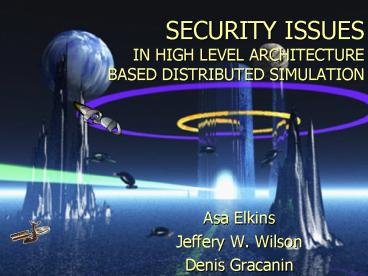SECURITY ISSUES IN HIGH LEVEL ARCHITECTURE BASED DISTRIBUTED SIMULATION
1 / 23
Title:
SECURITY ISSUES IN HIGH LEVEL ARCHITECTURE BASED DISTRIBUTED SIMULATION
Description:
Support development and conduct of operator training ... and support processes that can be trusted to downgrade (sanitize) data ... –
Number of Views:81
Avg rating:3.0/5.0
Title: SECURITY ISSUES IN HIGH LEVEL ARCHITECTURE BASED DISTRIBUTED SIMULATION
1
SECURITY ISSUESIN HIGH LEVEL ARCHITECTUREBASED
DISTRIBUTED SIMULATION
- Asa Elkins
- Jeffery W. Wilson
- Denis Gracanin
2
A Paper Presentation byRebekah BlackonApril
17, 2003Taken from the 2001Winter Simulation
Conference
3
Outline
- HLA
- Information Assurance
- Scenarios
- Filsinger and Lubbes Approach
- Bieber et al. Approach
- IPSec Protocol
- Results
4
Why Simulate?
- Support development and conduct of operator
training - Explore ways in which emerging systems can better
work together - Early detection and correction of deficiencies
5
High Level Architecture
- Purpose to substantially improve software
interoperability or reuse among DoD simulations - Combines simulations into a logical grouping,
called a federation
6
Information Assurance
- Simulation may involve national security or
proprietary interests - Need to guard simulation details against
unauthorized access - Goal to obtain adequate performance from the RTI
while using standard Internet protocols
7
Scenario 1 Distributed Development
8
Scenario 2 Distributed Test and Evaluation
Different levels of classification Need-to-know
access Releasibility
9
Scenario 3 Commercial Industrial Security
10
Filsinger and Lubbes Approach
- HLA must allow processing of Multi-Level Secure
(MLS) data among federates with users that do not
have all the appropriate security clearances - Information must be prevented from leaking from
high level to low level of security - HLA must support processes that are capable of
protecting information within a security
classification and support processes that can be
trusted to downgrade (sanitize) data - HLA must support security mechanisms to allow
object ownership and object attributes to be
safely read or updated by any simulation with a
federation - HLA must support enforcement of mandatory
confidentiality, integrity, and need-to-know
policies - Simulations must be reusable at different
security levels at different times in different
federations
11
Solutions
- Single security level
- (does NOT support multiple security principles or
domains or different classification levels) - Multiple single security levels with security
guards and trusted agents - (requires proper cryptographic protections)
- Multiple MLS security domains
- (requires MLS hosts and an MLS supported RTI)
12
Bieber et al. Approach
- Focus on application of security to HLA RTI in a
commercial sense and deals with confidentiality
of technology
13
3 Potential Threats
- Communications between local RTIA (Ambassador)
processes and the RTIG (Group) - Leak of sensitive object properties via supported
RTI processes, i.e. broadcasting too widely the
values of the sensitive object properties - Direct request of sensitive object properties by
unauthorized, but supported, federate processes
14
Solutions
- Network isolation -gt cryptography
- RTI isolation -gt security filter
- Require the federates in the same security domain
to be hosted by the same machine
15
Internet Protocol Security Protocol (IPSec)
- Interoperable with both IPv4 and IPv6
- Provides data privacy, integrity, and
authenticity for network traffic - Uses an on-demand security negotiation and key
management service defined as Internet Key
Exchange (IKE)
16
IPSec
- Communications between simulations and the RTI
need to be protected at a level commensurate with
the security level of the data. - Requests for data require a check of the
requester against the data.
17
Experimental Results
- RTI can support IPSec
- Minimal negative impact on performance
- (increase of simulation time lt10)
18
(No Transcript)
19
Results
20
(No Transcript)
21
(No Transcript)
22
Limitations of IPSec
- Does not ensure physical security of host machine
- Relies on external authentication and encryption
protocols - Affects performance as federation size increases
- Multiple security levels within machines allows
classification sharing
23
THE END.































